#royal armoury
Text


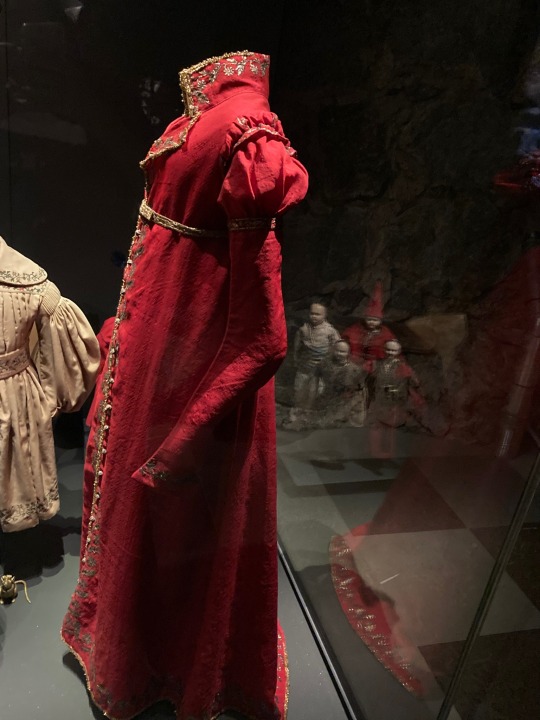
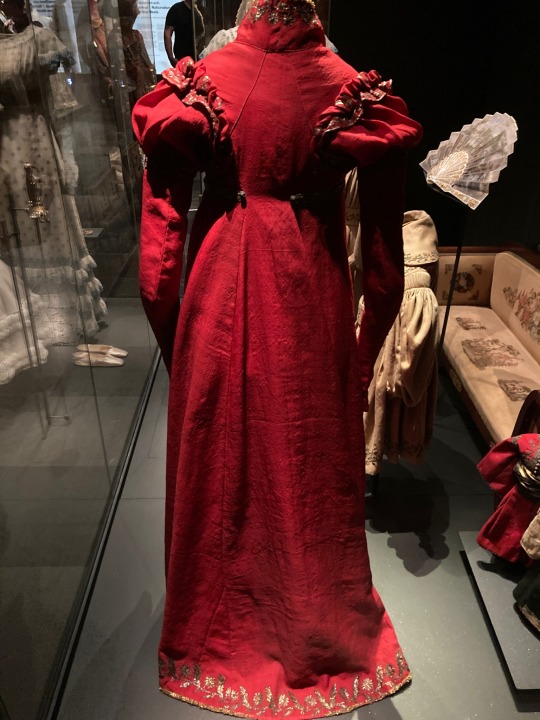


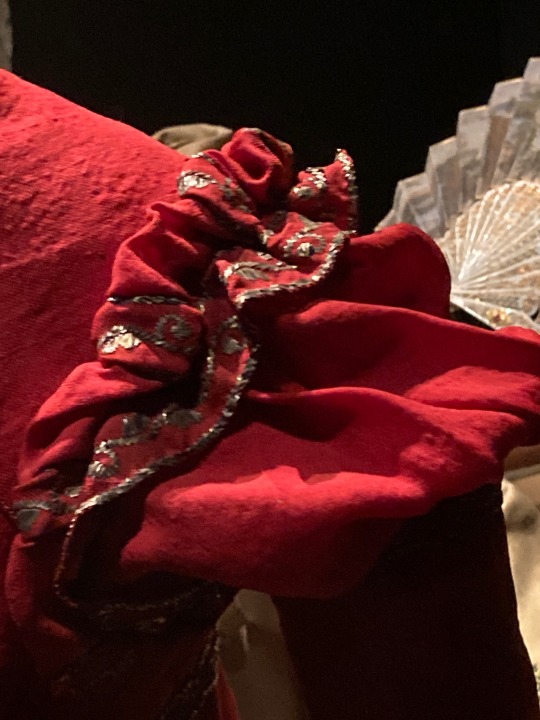
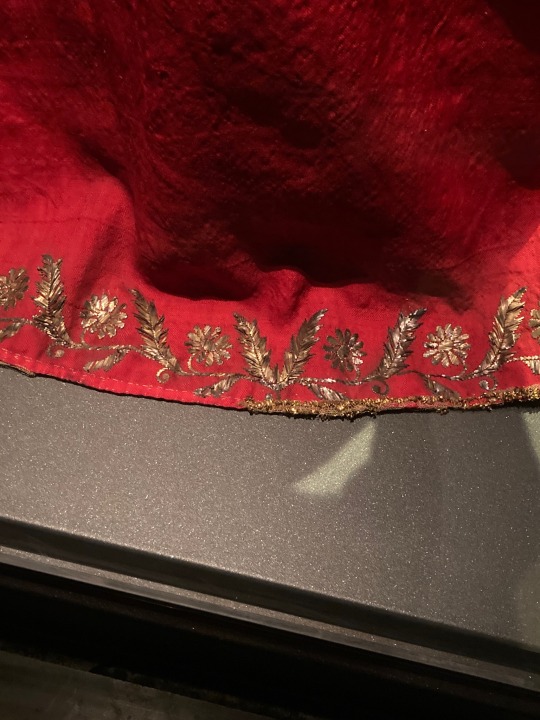

Crown Princess Josefina's Red Redingote With Small Gold Wire Buttons
Circa 1810s
The Royal Armoury
Stockholm, Sweden
#redingote#extant garments#1810s fashion#empire fashion#gold embroidery#gold buttons#crown princess josefina#royal armoury#stockholm#sweden
109 notes
·
View notes
Text
✨complaining about gabriels armour yay✨
DISCLAIMER (please read):
- i am doing this for fun. this is not a serious post.
- this is not a criticism of gabriel's character design.
- gabriel is an angel. obviously angels function differently to humans. the armour of angels in ultrakill could be purely decorative for all i know, but im evaluating it in terms of protection in relation to human anatomy.
- i often specifically refer to protection against swords. this is because i am basing my knowledge off of medieval armour. (what im saying is: i know v1 uses guns im not stupid)
- im not an expert on armour. i read about it for fun, as a hobby. if i get something wrong, PLEASE tell me i love getting new information about armour and i do not want to unintentionally spread misinformation.
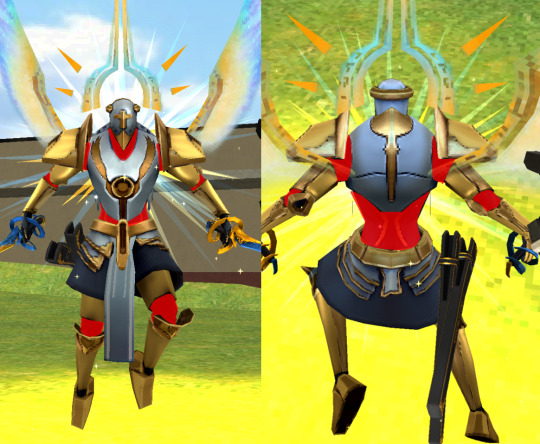
initially i did a quick assessment of the gaps in the armour, which would be weak points. while ive seen some interpretations of gabriel wearing a sort of bodysuit, he is definitely not wearing a gambeson. this would make the armour uncomfortable to wear as there would be no padding under it.
the rest of the armour evaluation is in the images below. all of the text is also written out in the image descriptions.

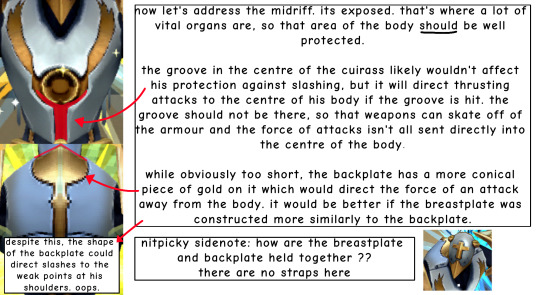
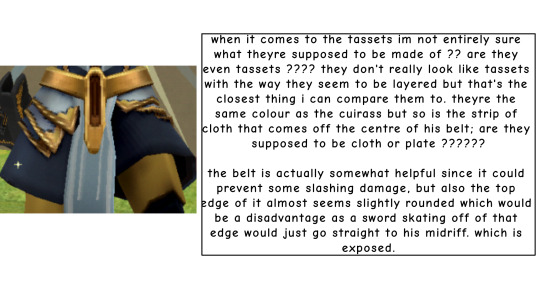

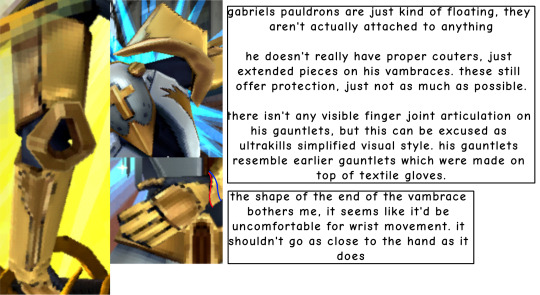
after all this nitpicking, i decided to try to redesign gabriel's armour to make it more protective while keeping it similar to his original design and still recognisable as gabriel ultrakill.

• lowered pauldrons so they're not floating
• added an aventail to the helmet to protect his neck
• the golden parts of the cuirass no longer go inwards
• didnt add couters because i suck at drawing them but lets pretend that i did that to stay closer to his original design (besides he still has the elbow pieces on his vambrace to provide some defence)
• his gauntlets have articulated fingers now
• tassets are laminated rather than the layers he originally had. in retrospect i should have done tassets of three lame and decorated them similarly to gabriels original design but oh well
• i also imagine that he would be wearing a hauberk under the skirt
• added extra plates to the poleyns as well as side fins
• he's got proper sabatons now
• also he would be wearing a gambeson under his armour
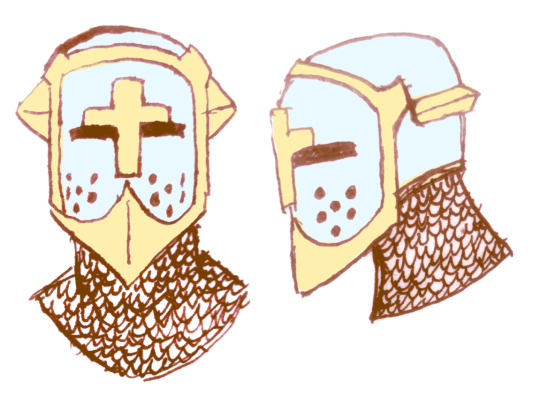
• helmet is more like a visored bascinet
• there are actual holes for ventilation now, and there's more of them.
• there are also holes for vision yay
• didn't want to get rid of the gold bit that goes around the helmet so i changed the shape so that weapons wouldn't get caught on it, but would instead skate off. i think it should come closer to the visor on the side profile though.
thank you for reading all of this i had a lot of fun doing this :-)
#my posts#ultrakill#gabriel ultrakill#went to the royal armouries museum once and it changed my life not even kidding
331 notes
·
View notes
Text



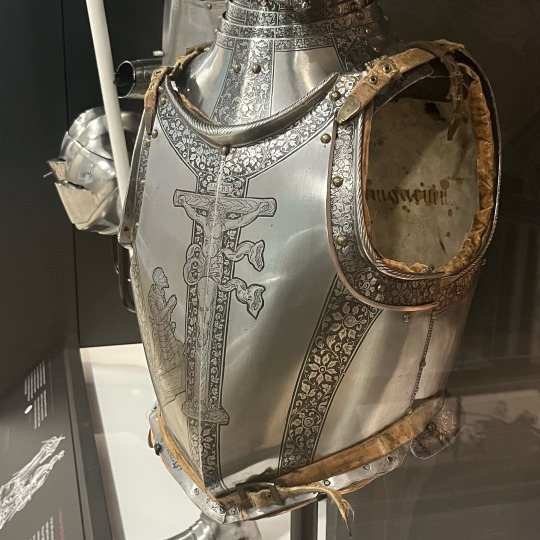
more armoury photos bc i want to go back and sketch there more
68 notes
·
View notes
Text



Sword (jian) and scabbard, probably made in the court workshops of the Yongle Ming Emperor. Chinese, Ming Dynasty, early 15th century.
The hilt is of gilt iron. The grip is of gibbous rectangular section, punched with small circles to imitate ray skin. Down the centre of the front is a raised spine bordered by tiny flames at either side.
The pommel is of trilobed form, bordered at the front and rear by bands of golden scrolls. The front panel of the pommel is chiselled and fretted with a dragon surrounded by interlacing flames, with triple claws on each paw. At the rear of the pommel, the central panel is decorated with a monster mask (kirtimukha), surmounted by a silvered crescent and golden disc, and with human hands, also surrounded by flames. At either side of the pommel are the Eight Buddhist Emblems of Good Augury (ba jixiang): the wheel of law (dharma), the standard, the treasure jar, the pair of fish, the endless knot, the lotus, the parasol and the conch shell of victory.
The guard is embossed in the form of a monster mask, surmounted by a silvered crescent and golden disc. The face is punched with circles, the canine teeth silvered, the eyebrows and whiskers chiselled and gilt. The horns are in the form of crab claws. At either side of the mouth is a paw in the form of a human hand. The head is surrounded by scrolling curls of mane. The rear of the guard is rendered as the underside of the jaw, with a set of silvered teeth, and a narrow beard running into a throat of alternate silvered and gilt bands.
The blade is associated but is probably a later replacement of Tibetan manufacture. It is formed of pattern-welded steel, of diamond section, straight and double edged. The pattern welding produces a mirrored pattern of addorsed crescents at either side of the medial ridge. The tang is of rectangular section, tapering towards the pommel, with a large expanded peg-hole towards the end. The edges have been ground and sharpened.
The scabbard is of wood covered in green stained leather and bound with gilt iron. At the throat is a V-shaped cut out at the front for seating the blade, and a scalloped cut-out in the leather to accommodate the guard. The throat retains traces of the scarlet silk with which it was lined. The iron binding comprises a long, facetted strip running all the way round either edge.
There are eight transverse bands at the rear, the uppermost and fourth of which are wider than the others, and extend round the front of the scabbard forming suspension loops. The edging strip has four main facets, with an additional narow facet at either side. It is decorated with scrollwork in gold running down each facet, and matching that on the pommel. At either end is a set of three golden lotus leaves.
The front panel is divided stylistically into upper and lower sections. The upper section is decorated quite plainly; a series of five beaded transverse bands divide it into six sections, and there are three vertical bands of fretted four-petalled rosettes in each section.
At the throat is a cusped section with a beaded border, below which is a band of flames. The ornate lower section has six smaller segments, divided vertically and horizontally by fretted 'vajras', each with a 'yinyang' symbol in the central knop. The half-'vajras' at either side emanate from the heads of lions, and the vertical bands of decoration at either side are formed by rows of flames.
Above and in the middle of these divisions are two square panels, each containing a cusped lozenge shaped central medallion, the corners decorated with interlacing flames. The uppermost of these two panels contains two dragons intertwined amid flames, with the heads at top right and bottom left; the lower has two similar dragons, with thicker bodies, and with their heads confronted at the left and right.
The chape section is decorated with a large panel of interlacing flames, within a beaded border. At the rear of the scabbard, the upper band is decorated with alternating gold and silver scrollwork, and terminates in a rosette at the front. The next two narrow bands are decorated with silver scrollwork only. The fourth is decorated at the rear like the top one, but is extended accross the front in a broad band; it is chiselled with four medallions decorated with gilt characters on silver grounds, and surrounded by interlacing gilt flames. The three lower bands are decorated in gold scrollwork.
The rear chape panel has a small, flat piece of rather coarse, scrolling interlace at the bottom, and narrow bands of petalled rosettes at either side.
A four character Tibetan inscription on the lower suspension loop reads 'khi'u ga ral gri' (honourific sharp sword).
China, 15th century (About 1420),
Leather, Ferrous, Gold, Silver, Semi-precious stone, Silk, Wood,
Dimensions:
Blade Length: 30 inches
Overall (sword) Length: 35 inches
Courtesy: Royal Armouries Museum, Leeds, United Kingdom
Sword (jian) and scabbard, probably made in the court workshops of the Yongle Ming Emperor. Chinese, Ming Dynasty, early 15th century.
#art#history#design#style#sculpture#silver#gold#semi precious stones#royal armouries#leeds#silk#wood#sword#jian#scabbard#ming#15th century#yongle#imperial
43 notes
·
View notes
Text
Ian McCollum interviews Jonathan Ferguson, Keeper of Firearms and Artillery at the Royal Armouries Museum in the UK, which houses a collection of thousands of iconic firearms throughout history.
youtube
(p.s. @baldy-wan-kenobi, check out 23:38-27:28)
#forgotten weapons#royal armouries#jonathan ferguson#keeper of firearms and artillery at the Royal Armouries museum in the UK#which houses a collection of thousands of iconic weapons from throughout history#Youtube
10 notes
·
View notes
Photo
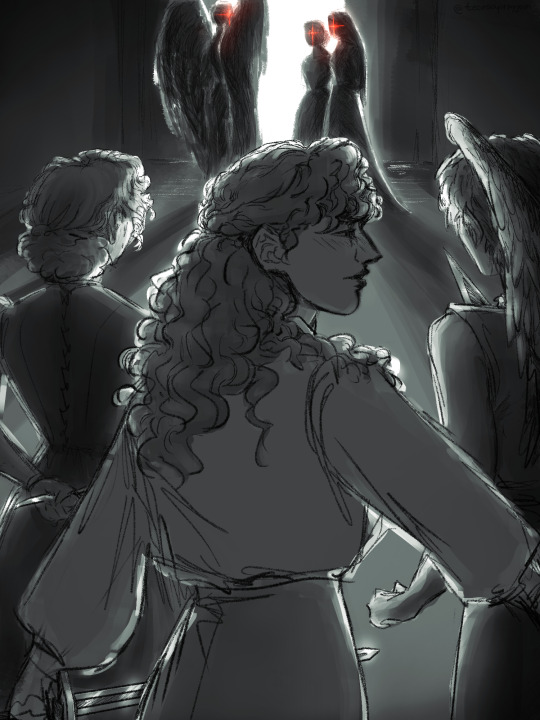
“what could possibly go wrong?”, famous last words from my commander
I was having thoughts about @exilethegame (as usual) and started wondering about what kind of shenanigans the mc, syfyn and esme got into as kids:’)
#the exile#the exile fanart#syfyn#esmerelda#marcelle#emeline#the exile if#let's steal from the royal armoury! they're never going to find out!!#poor esme has the tiniest knife.. she was forced into it#also... baby commander vesta:')
244 notes
·
View notes
Text

I have not been normal about decorated borders on visors today
#it looks so good#this is the one from the royal armouries btw#I've been thinking about it since I saw it from the post before#bascinet#15th century
4 notes
·
View notes
Text
Aph Austria x Spain Headcanon
I’ve been lately thinking about Spain and Austria, because it is shocking (not really) that there’s so little content about them and that most people don’t even think of them as a couple (it is even listed as a “rare pairing” in Hetalia wiki), given it is one of the few stablished official pairs in Hetalia, to the point they’re shown to be married (and no, I don’t mean having an alliance, or cooperating, I mean, it is indeed stablished they were a married couple).
Tbh, this ship was not particularly appealing to me either, even though I usually like my ships to be historical, and you can hardly get much more historical than a Spain/Austria ship. I’ve always thought their personalities and tastes appeared to be too different to match. And no, I did not buy into the initial portrayal of Spain as a total airhead, happy-go-lucky, relaxed and smily guy, but still, they didn't do it for me (though the fandom largely exaggerated such traits, as Spain is actually shown to be sad and disappointed, and as someone somewhat wise, in one of his early appearances in the show). I think I always thought of Roderich personality to be too over the top. It’s okay to be strict (like Ludwig is), but he just seemed to be way too strict, way too proper, way too desdainful, way too bland and dull, at all times. There must be more to him that what we are shown, right?
But I have these moments when I think about how actually close they were, and about Austrians’ rather good opinion on Spaniards even after their countries’ estrangement (and not in a good way, I must add). I think about how Austria tried to mimick the very strict rules of the Spanish Court (Spanisches Hofzeremoniell) and the way the Spanish dressed (Spanish fashion was widespread at the time, as was Spanish culture, and language, but was specifically imitated in the Austrian Court), how he valued Spain’s experience and knowledge when it came to equestrian tradition (Spanische Hofreitschule), and how he enjoyed and liked Spanish composers (like Vicente Martín y Soler), even decades after they had fallen apart. Austrians also seemed to have considered Spaniards to be intelligent and wise people, powerful, but benevolent in battle, well dressed, lordly behaved, and righteous. Ironically, they thought the vice of Spaniards to be arrogance and vanity (funny it is apparently Roderich who comes off as the arrogant one in Hetalia, though, truth be told, everyone at the time seem to have thought of the Spaniards as arrogant and/or vain).
All in all, it has become a headcanon of mine that Roderich probably became the way we know him AFTER being married to Spain. Yes, I know in canon he is shown to be already that snooty before meeting him, heck, it is even said he gave Southern Italy to Spain, when actually those territories had belong to the Spanish monarchs (Kingdom of Aragón) for almost a century before Spain and Austria became acquainted, and it is historically pure nonsense to even imply the Kingdoms of Sicily and Naples, and Sardinia, were granted to Spain by Austria, when Spain (really, the Spanish monarchs of the Kingdom of Aragón) even had control over Malta at the time (though it would lose it in 1530, soon after their “marriage”).
Making it simple, I headcanon Roderich to become as “stiff” as we know him to be during his marrige with Antonio. It is a classic case of “overdoing it” (in Spanish “tener la fé del converso”, o “ser más papista que el Papa”). We know Austrias’s way to climb the social ledder of countries and to hold on its position as a powerful and influential nation was through marriage. So he had to be good at that, he had to be up to his couple, up to what his couple may expect of him. So he became everything he thought Antonio valued. Spanish Court ceremonial was strict, so he would become the most severe of them all. Spanish people valued etiquette, so should he. Spanish fashion was over elaborated, and so was Austrias, and when the tides turned and French fashion was in, Austria would stick with certain elements of old Spanish dresscode for a bit longer (I’m thinking about the men's court dress of Austria in the 17th-18th centuries, the Spanish Mantelkleid). Spain was known for elegance, and so was Austria. Spain was precise, careful, a bit haughty in his behaviour and mannerism, and more so ought to be Austria. All in all, Austria modelled himself to became the “perfect” match for Spain, at least for the Spain he knew.
I think Roderich took into this character part to please Antonio, part out of duty for his people, and part because it suited his interests and tastes. While Antonio slowly loosened up, Roderich made this new image his own, for he was comfortable with it and it suited him well. I don't think Antonio was ever unwilling to show a severe self image, I don't think his demeanour was a façade at all. It was no play, the sternness and haughty behaviour was genuine (if anything, it is his laid-back attitude and overly smily self that is, albeit not completly fake, a bit of a façade, for although he is of a cheerful and optimistic nature, time has worn down his optimism and has pushed him to the limits of his sanity more than once). But I do think he naturally softened and relaxed quite a lot when not "in duty", so to speak (relaxed as in less composed, showing more his emotions, expressing his feelings, fears, and needs, I actually think he must have been half paranoid most of the time). Roderich did too, but became so attached to his image of tidiness that it became a bit harder for him to let go, hence the contrast between him and Antonio, more so in modern times.
For whatever reason, imagining Roderich’s personality taking its final form during his 200 years relationship with Antonio makes sense to me, and makes me like and appreciate the pairing quite a lot. I guess I was just missing some more information on Roderich’s behaviour and personality.
I hope that no one takes offence by my take on Roderich personality and its evolution. I’m well aware Austria has a very rich history, and I do not intend to make Spain the corner stone of Roderich’s identity, it is just that I was missing some “origin story” for Roderich, some explanation for his character. And it makes sense Antonio played a very important role in his life, given they got stuck together for 200 years while in their late teens/early adulthood, while still finding themselves out, and the ending of their relationship was a war involving several countries and power houses in Europe, during which Austria was just not willing to give up, and Spain went through a rough civil war (and probably an emotional turmoil, worrying and being suspicious of Roderich's, and mostly Francis', intentions).
#aph spain#aph austria#antonio fernández carriedo#roderich edelstein#spaus#aph#hetalia#also#I had no idea#a friend of mine is visiting spain this summer and we're going to visit the royal palace of madrid#and i was planning to take a peek at the Royal Armoury as I had read it was one of the best#and most important collections of its kind in the world#i was looking at the official webpage today and just read the other one that matches its importance is in Vienna#lol#so great#but yeah#i love in the show we see Spain getting exited about an old sword that Romano gave to him#and Romano commenting on Spain's interest and love for old weapons#i think it was a roman sword#not surprised Antonio was so exited#I would have been too
29 notes
·
View notes
Text

Karl XV, King of Sweden and Norway, Carl Fredrik Kiörboe, ca. 1860
#art#art history#Carl Fredrik Kiorboe#portrait#portrait painting#equestrian portrait#Swedish art#Scandinavian art#19th century art#Royal Armoury Stockholm#oil on canvas
49 notes
·
View notes
Text

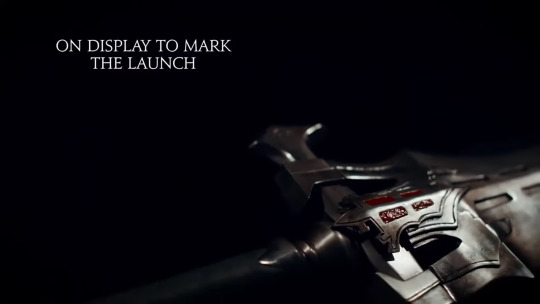
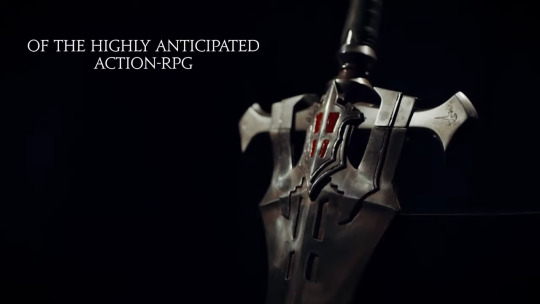


Final Fantasy 16 x Royal Armouries - Official Invictus Sword Collaboration
#final fantasy#final fantasy xvi#rpg#medieval fantasy#fantasy#swords#gaming#art#video games#england#united kingdom#clive rosfield#royal armouries#ffxvi
15 notes
·
View notes
Text
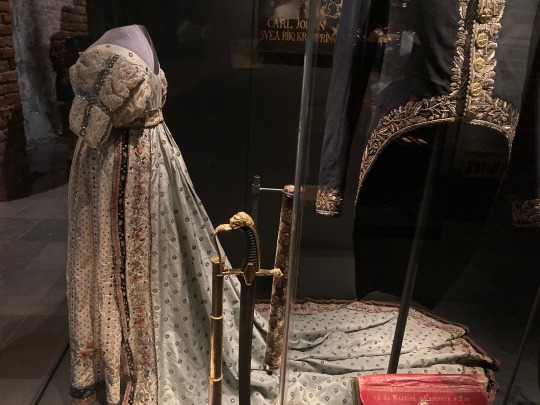









Princess Sofia Albertina's Court Dress For The Coronation Of King Karl XIII Of Sweden
1809
The Royal Armoury
Stockholm, Sweden
#princess sofia albertina#court dress#1809 dress#empire fashion#extant garments#1800s fashion#sequins#royal armoury#stockholm#sweden
27 notes
·
View notes
Text
instagram
🗡️The classic Italian Longsword from Balaur Arms returns with a twist🗡️
We asked swordmaker and martial artist LK Chen to not simply reproduce the original model, but to further optimize it to create a performance longsword. In addition to a host of material and construction improvements, LK Chen was able to achieve outstanding balance and performance characteristics with the use of substantial distal taper and faithfully executed hollow-ground blade. In the hand the sword is a natural extension of the arm and deft enough to be used with a single hand if necessary, but it truly comes into its own when wielded in two hands. A quick striker with a fast recovery, this is a sword that can keep pace with the speed of your mind in the duel.
In stock and available to order now
Thank you @thejade.eye for the video.
#Kult of Athena#KultOfAthena#Balaur Arms#15th Century Italian Longsword#LK Chen#sword#swords#weapon#weapons#blade#blades#European Swords#European Weapons#Medieval Swords#Medieval Weapons#Longswords#14th century#15th century#Royal Armouries#the Black Prince#Edward the Black Prince#Brescia Spadona#Musueo Civico#GB 60Si2MnA High Carbon Manganese Spring Steel#Battle Ready#Instagram#videos#thejade.eye
2 notes
·
View notes
Video
youtube
Beretta M93R: Exploring the 'Robocop Auto 9', with firearms expert Jonat...
Manufactured by KFC of Japan.
Manufactured by KFC OF JAPAN. I know it’s only an AirSoft replica, but seriously, US? Are you going to let Japan sell Auto 9′s in KFC, and not even TRY to catch up?
This shows how the Robocop Auto 9 was made from a Beretta 93R. It then shows you how the Beretta 93R works. 3 round burst is the most complicated to make. Fully auto is easier than semi-auto. Semi-auto requires a seer to catch after each shot. Multi-round burst requires the machine to, naturally, count, mechanically.
The Beretta 93R was created as part of the older idea of an automatic pistol with a stock. The stock collapses either on the weapon, or can be removed and collapsed to an extremely small size, while still apparently being quite a stable stock.
The idea was something pursued by a number of countries, and then abandoned. The idea goes back to the Artillery Luger, where you can add a stock to a pistol. Then, with the advent of automatic pistols, the stock would allow the user to control it, effectively turning it into a submachinegun.
The Beretta 93R apparently does it’s job quite well. The grip is slightly bigger to hide the ratcheting mechanism. The foregrip and stock work quite well, and the 3-round burst makes it quite controllable.
Runtime: 18:51
2 notes
·
View notes
Text
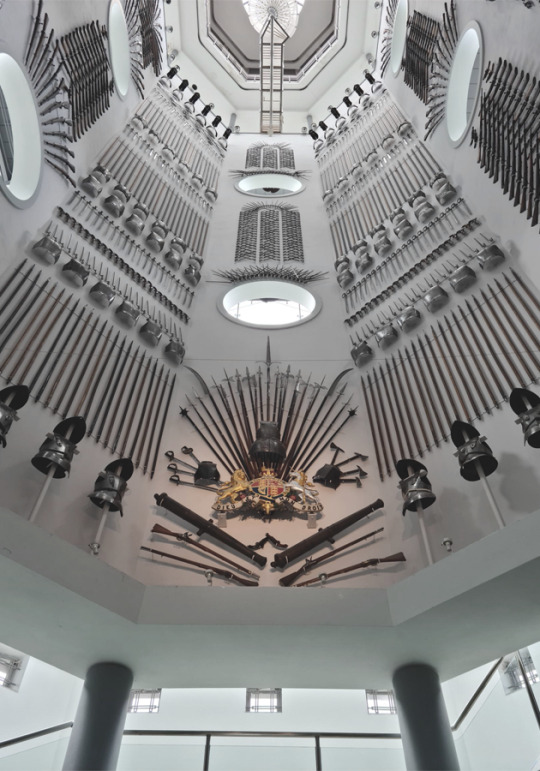





I visited the Royal Armouries Museum in Leeds earlier this month with @skeevers. Loved it. Would recommend.
#also that is apparently the only remaining example of elephant armour in any museum in the world#Royal Armouries Museum#Leeds#weapons#armour#medieval#warfare#mine#flail#mace
5 notes
·
View notes
Text
youtube
#helldivers#helldivers 2#jonathan ferguson#the Keeper of Firearms & Artillery at the Royal Armouries museum in the UK#which houses a collection of thousands of iconic weapons from throughout history#gamespot#Youtube
7 notes
·
View notes
Text
I need to eat sheet metal (beautifully engraved armour from the 15thcentury using acid resistant wax that allowed the blacksmith to etch detailed designs in the armour using a needle like tool, and when the acid is applied it ate away at the surface of the exposed metal allowing the etched design to be visible against the armour itself)
#normal about renaissance armour btw#my trip to the royal armouries is making me fucking insaaaaane I need to bite something in my excitement ro#☕️
2 notes
·
View notes